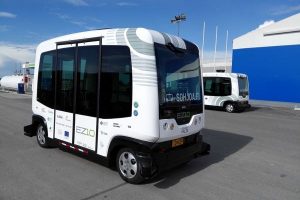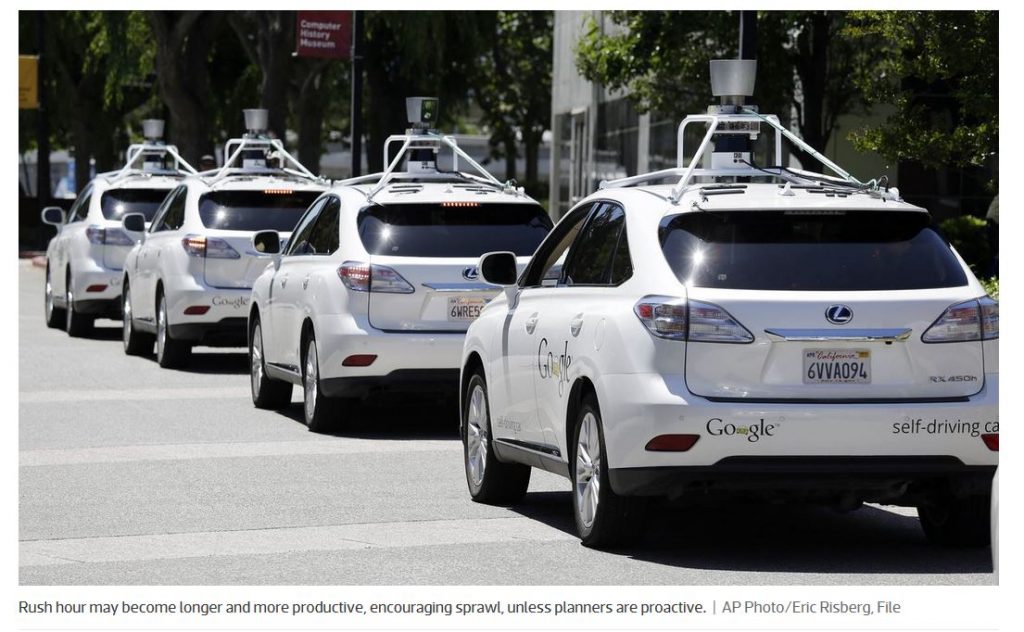
Imagine living 3-4 hours away and waking up early to crawl into your auto-car and going back to sleep while it drove you in to work…
The futuristic vision offered by automated vehicles—the freedom to be active during your commute instead of wasting away behind the wheel while stuck in traffic—isn’t quite as utopian a scenario when you run it past cautious and concerned city planners.
The convergence of three new technologies—automation, electrification, and shared mobility—has the potential to create a whole new wave of automation-induced sprawl without proper planning and regulation.
“This will completely change us as a society,” says Shannon McDonald, an architect, assistant professor at Southern Illinois University-Carbondale, and an expert in future mobility planning. “I think it’ll have the same transformational change as the introduction of the automobile.”
Real estate firms will negotiate for fewer parking spaces, perhaps even setting up their own agreements with autonomous bus or transportation-network companies, such as Uber or Lyft, to provide tenants with transportation access in exchange for gaining more usable, high-value urban space. Though banks and financial institutions will need to get on board with the concept, this would offer a new way to add density, and could help spur more mixed-use, walkable cities.
The question marks around AVs cut both ways; some believe AVs could also be tools for sprawl, since commutes will suddenly be more enjoyable and “not everyone can live in funky lofts.”
Just as driverless car technology will speed up a change in the way cities think about parking allowances, it’ll also accelerate a shift in how we design roadways, specifically pick-up and drop-off zones for vehicles. The growth in services such as Lyft and Uber are beginning to make this issue clear, but as autonomous vehicles eventually hit the streets, the way buildings and developments welcome and adapt to traffic flow will become increasingly important.
“Our streets aren’t designed for door-to-door service,” says McDonald.
New land-use rules and traffic codes will need to be designed to properly funnel AV traffic and prevent what could be a series of bottlenecks on the road, especially during rush hours, as people get to and from work and school.
Redesigning parking lots and entrances to be less about static parking and more about increasing the flow of dropoffs and pickups, as well as serving as staging areas for driverless cars not in use, will both free up space and ideally protect roadways from potential congestion.





Imagine waking up, thanks to the G-force created via your driverless car’s acceleration limiter being defeated by a software hack introduced over its wifi feature, to the view of the back of a mac truck, a brief second before never waking up again. A few of them type scenarios will ensure that “people-moving” ain’t happening for the next generation.
Besides, releasing your fundamental rights to strangers isn’t as popular as those who dwell in their facebook and google ghettos would like to believe. See “google glass.” Really great idea, according to google, lots of money spent on it, till folks figured out it was fundamentally evil.
You have to eliminate people from the equation. As long as there are human drivers sharing the road, it’ll be a mess. From a clean slate, with only driverless cars – no other cars, no bikes, no pedestrian interaction – easy peasy. Progamming to account for the human factor – nearly impossible.
Google’s experimental deployment in AZ portents less about autonomous private vehicles and much more about the future of public transit. Labor (drivers) make up 80% of transit operational costs. Transit agencies favor large vehicles to carry the most passengers per driver, but this results in less frequent service on fewer routes. Autonomous vehicles will allow efficient use of a larger number of smaller vehicles, with more flexible routes and schedules. Couple this with payment, hailing and position reporting on a mobile app, making for a much more appealing service (I used Lyft for the first time last month, and discovered I had greatly underestimated how much being able to see your assigned vehicle in route contributed to a positive experience.) Also I think Google and others will discover that giving vehicles an Alexa-like “attendant” will greatly improve passengers’ acceptance and confidence.
As for the 3-hour ride to work, that will become part of my work day, the quiet time to focus and concentrate. Time at the office will be for meetings, stand-ups, and collaboration. Current Silicon Valley tech companies cram employees into “open plan” cattle pens that are chaotic and distracting. My car has about 5x the square footage than I am assigned at the office (and I’m one of the lucky ones to have an assigned location; others have to jockey for position and power outlets in shared spaces) I would welcome a rolling cocoon to be able to work in peace several hours per day. And most companies are much more amenable to “work commutes” than “work at home.” Showing up for at least part of the day counts for a lot.